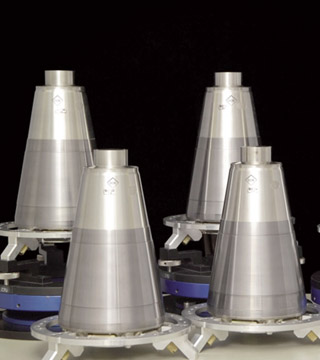
THE KANSAS CITY PLANT delivered these first arming, fuzing, and firing units for the W76-1to the Pantex Plant near Amarillo, Texas, in mid-2007. (Photo courtesy of Org. 2222)
Sandia’s Life Extension Program to replace the W76 warhead in the nation’s stockpile with a refurbished version, the W76-1, has provided a roadmap for weapon system modernization work to come.
Production on the W76-1 began in September 2008 and is slated to run for several more years. The original W76, what manager Nick DeReu (2222) calls the “Mod-0,” has been extended beyond its original service life in the stockpile, he says.
He believes the W76-1 program has set the stage for work to follow on other systems, such as the W88 Alt370.
The Navy’s submarine-launched ballistic missile carries the W76-1 warhead, which is part of the US defense triad.
Sandia is responsible for helping extend its service life, including replacing the weapon’s arming, fuzing, and firing subsystem (AF&F), Nick says.
“The end game is to put something in the stockpile that’s going to work every time if needed,” he says.
Finishing production on the W76-1 also will free production capacity at the National Security Campus in Kansas City and the Pantex Plant in Amarillo, Texas, for upcoming production on the W88 Alt370 and the B61-12 Life Extension Program (LEP), he says.
“The B61-12 LEP is more complex, just in design and complexity and the sheer number of parts,” Nick says. “The scale is completely different from the W76-1. Both are going to turn out to be very demanding programs.”
Centers 400, 1700, 2200, 2500, 2600, 2700, 2800, 2900, and 5300 support the W76-1, “so it remains a significant effort for the Labs,” he says.
The current challenges in the W76-1 program are centered on production, Nick says. The Kansas City Plant has been moving from an older production facility to its new National Security Campus (NSC) about 10 miles away, adding new challenges to the production schedule.
A dual-build approach
That requirement necessitated a twofold approach of build ahead and dual build. In the build-ahead approach, the Kansas City Plant built enough of particular components at the old facility to bridge the amount of time it took to get that production started at the NSC. Sandia and Honeywell FM&T, which manages the NSC, worked together to ramp down production at the original facility for both production lines, making sure the work at the new plant met requirements before shutting down the line at the old one, Nick says.
“That’s all gone remarkably well. We didn’t miss a beat,” he says.
The team also kept production going over the last year at the Pantex Plant while working through facilities issues. Sandia’s release of updated weapon response information in July 2013 marked a significant milestone for the program.
Surveillance activities will continue to ensure the W76-1 Reentry Body Assemblies in the stockpile are safe, secure, and reliable. “Surveillance provides us the confidence that what we’re building for the Mod-1 is functioning properly and meeting reliability requirements,” Nick says.